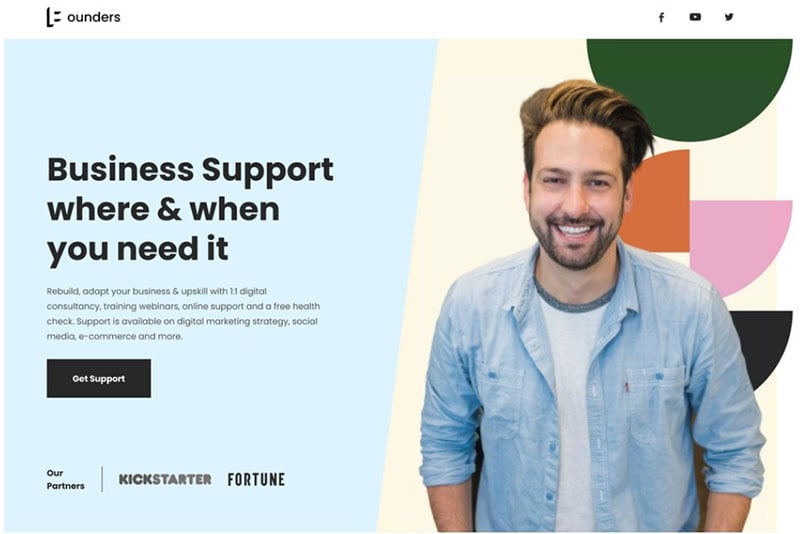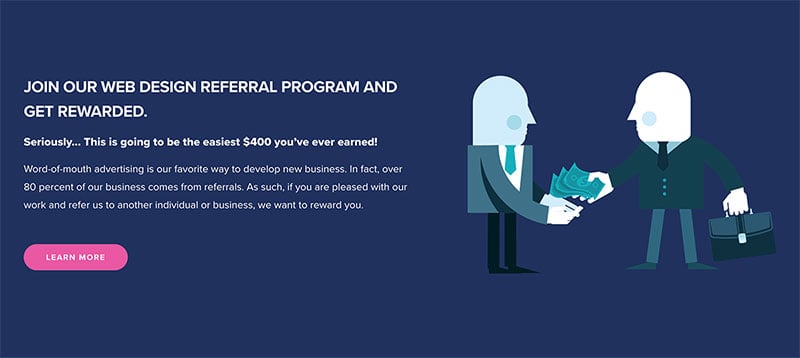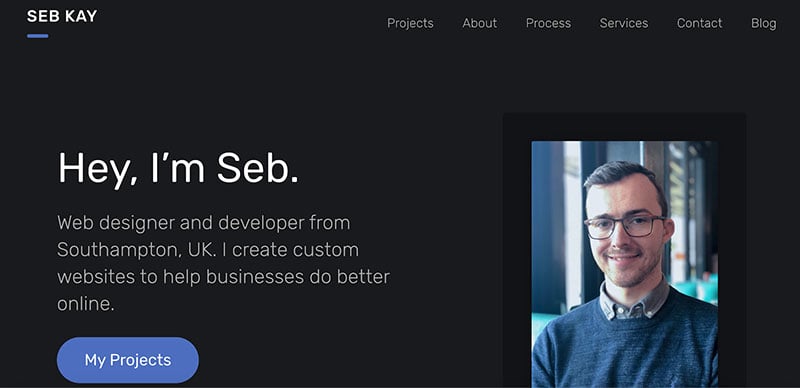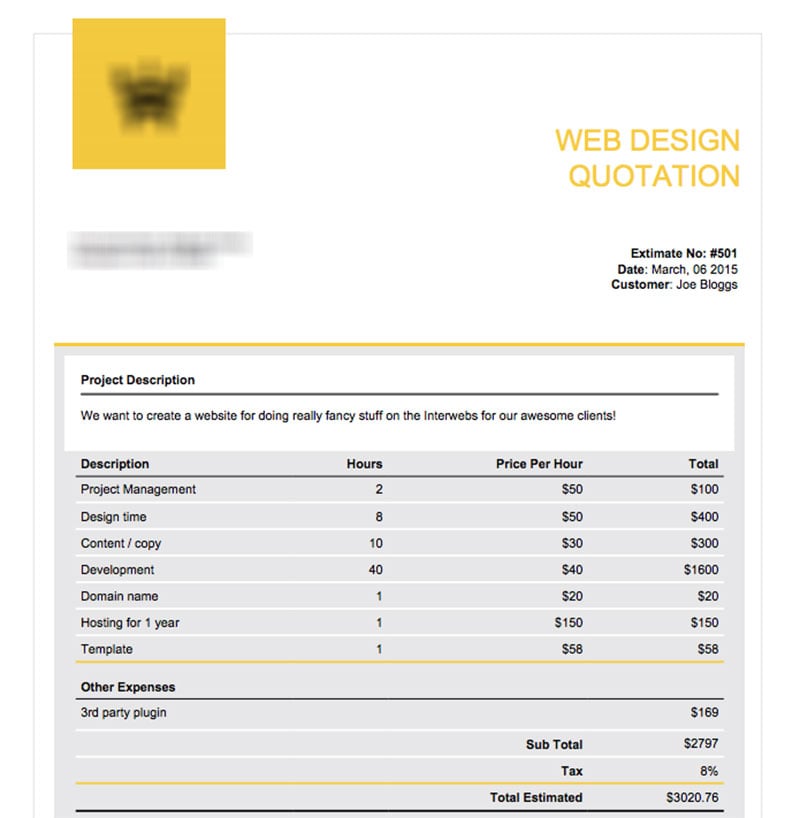Website design pricing depends on multiple factors. Timeline, location, the scope of the project, and web design costs are some of these factors.
Setting web designer fees can be a challenging task. You want tochoose a competitive price and make a profit at the same time.
There is no mathematical formula nor a set of rules for web designers to put a price on their services. But there are some general tips that will be useful at the time of making this decision.
A website designer usually charges $75 an hour, but this can change with circumstances. They can choose to reduce the hourly rate for long-term projects or their usual customers.
A web designer fee can vary if the client requires only a landing page or a complete website. Or if they want to improve their existing site or build a new one.
It can also vary according to the complexity of the site or design. Websites with inventory management, a payment platform, responsive design, or premium plugins, can generate an extra cost.
This article presents a useful guide for those who want to set out their website design pricing. Here, you will find the essential aspects to consider when providing a quote to a client.
Website design pricing: know your value

Putting a price on your web design services can be a challenge. A freelance web designer needs to carefully assess the time/reward ratio on each project.
If charging a high fee, you face the risk of losing clients. However, if the fee is too low it won’t be possible to pay the bills, or it will pay them but not make a profit.
This may force designers to accept many projects to make up the deficit. Yet it will likely become difficult to meet all the deadlines.
As with everything in life, website builders and designers need to find the right balance.
Consider the following questions:
- How can a designer choose the best web design prices for their services?
- Should they charge by the hour or by the project?
- Should they work for a web design agency or as a freelance web designer?
While the average cost for web design services is $75 an hour, the fees start at $60 an hour. The costs will depend on the type of service and client, the site’s functionality, and how many pages it will have.
A professional designer can charge between $5,000 and $10,000 to build a business website. Most businesses need complex features like online payment, subscription managing, live chat, etc.
Building and designing a professional website has an average cost of $6,760.
Web design agencies can have higher fees as they face more costs. Custom web design is usually more expensive.
Website design pricing usually includes client training and maintenance of the site. Therefore, it’s necessary to consider your future expenses and availability.
Estimating your expenses is not as difficult as it sounds.
The minimum fee to charge will depend on the web design cost. It should also provide the income that you need for a comfortable lifestyle.
If you want to charge more than this, consider the target market, your experience, and your skills.
The basic necessities to build a website are a hosting provider and a domain name. After that, there are numerous possibilities that will increase the website design costs.
These include:
- security measures
- premium plugins
- website themes
- amount of sections and pages
- multi-language features
- automatic translation
- integration with other platforms
- live chat services
- technical SEO
- SEO strategy
Web design pricing guide
Essential factors to consider when establishing website design pricing and fees
If you are looking for a simple formula to establish your website design fees, then stop looking. There is no right answer.
There are, however, some important factors to consider. Analyzing these factors and establishing your goals is the first step.
Consider how much income is necessary to keep the business running and maintain the desired lifestyle.
Then, establish your exact services and the amount of time needed to deliver them. If possible, offer advanced features in your portfolio so you can charge more for them.
Finally, estimate the time/profit ratio and establish the fee. When a new customer approaches with a new project, you will be able to make a quotation according to their needs.
During this process, though, there are several factors to consider. The next section presents a guide to choosing the best website design pricing.
Technical skill and web design experience

Professional web design prices depend on the web designer’s skills and experience.
One recommendation is to compare the quality of your work with competitors. This will show whether one can charge a higher fee than them.
At this stage, ask the following questions:
- Do I have a good reputation as a website designer?
- Can I offer features and services that my competitors can’t?
- Do I have more experience than them?
To answer these questions, it helps to set out a ranking, e.g., from 1 to 5. This will provide a realistic vision of your possibilities and strengths.
Some web designers are outstanding at some tasks but average at others. The more honest the answers, the better for the business.
It helps to consider factors like skills and portfolio size. Clients that are willing to pay more usually look for a larger portfolio before hiring a website designer.
Focus on growing your portfolio and always consider the target market.
Types of websites

Web design costs and fees depend on the type of website.
A personal website requires much less work than a business website or an e-commerce platform. Certain features such as a shopping cart or a secure online payment option take more time to prepare and set up.
Moreover, an online store is expected to generate more profit than a literature blog. For this reason, website builders charge them higher fees.
Likewise, the fees differ for a small business website, like a clothing store in a small town, and a large business site, like a national tech store.
The types of websites include:
- Membership sites
- Websites for small to medium-sized businesses
- Websites for online small to medium-sized businesses
- Large e-commerce sites with a virtual or physical presence
- Large shops with a brick-and-mortar presence
- Blogs
Time frames for web design

A website builder must have an idea of the delivery time for a project. The longer the project, the higher the fee.
Time is money. For this reason, do not give away your work.
Every task or feature that a client asks for should be considered in the quotation. Make it clear that any extra feature added during the process, will generate extra costs.
It is important to consider the difference between billable and non-billable hours.
The former are the hours spent working on tasks that generate money. The latter is time spent on tasks that don’t generate profit but are vital for running the business.
These tasks can go from wiping the floor to admin work and equipment maintenance.
These standards differ for every professional. Charge them as you consider necessary.
Web design costs
It is important to estimate web design costs ranging from the lowest to the highest fees. A quotation should include:
- travel expenses
- costs for hiring developers or support
- templates
- hosting cost
- custom images
- stock images for the web design project
A website builder should also consider the ongoing expenses of running the business. These include digital marketing, insurance, telephone or internet bills, page builder’s costs.
By analyzing the expenses, a designer will be able to obtain more profit. Consider this from the very start of the quotation process.
Find your niche

Consider the audience. Finding the right niche and getting to know it is key to succeed online as a website builder.
Clients in the financial industry usually look for the best price and the higher profit. Therefore, it is difficult to get high fees from this niche.
Try starting with a small business website or a reduced niche with lower competition. This will allow a designer to get more clients.
While it is hard to find a small niche with the probability of charging high fees, it is a good way to start.
It is a great idea to take this approach at the beginning of a website design career. Nonetheless, in the future, the goal is to increase your earnings to make the best of your time.
At this point, use your experience as leverage. Move to more challenging niches to get better payments.
It is wise to keep taking courses and acquiring new skills. That will provide value to your work and give you a better position in the market.
Demand
A website builder career is a long-term project. It is almost impossible to get the best clients without a portfolio or a reputation.
Beginners may want to reduce their fees in order to create their portfolio, acquire experience and build a reputation. Remember that many people hire professionals based on personal recommendations.
Considering the web design cost and the potential expenses is necessary. But it is also important to consider demand.
From a realistic point of view, if you reject a project make sure to have something to fall back on. This can be a similar project or even savings.
If you have not worked for some time and don’t have many offers, then consider lowering the fee. This will allow you to compete with other players in the market.
Those with a regular workflow can afford to maintain their fees and even increase them.
If there are so many clients and inquiries that it’s hard to keep up with work, then you must be doing something right. People undoubtedly like the way you work.
Don’t be afraid to take this opportunity to increase the fees. Optimize your time for learning new skills, taking courses, or developing your business.
Improve your website, study new niches, take courses. The best investment possible is to invest in yourself.
Know the web design market
In order to establish your fees, it’s vital to know the market’s website design pricing. For this, check competitors’ websites or research freelancer platforms.
Website builders must have a clear understanding of how the market works. They can then choose the niches that they feel most comfortable with.
The following questions will be useful at this stage:
- Compare your fees and services with those of competitors. This will help form a realistic view of the market.
- Are the services available locally or internationally? Establish the countries or cities where you will offer website design services.
- Will you accept smaller projects like logos, banners, landing pages, blogs? Or only larger ones like complete websites?
- Will you work with a small business? Or are larger ones preferable, like a company website or e-commerce platform?
Required features
The more features a site requires, the more time it takes to set up and maintain. This also means more work for the designer, hence a higher profit.
The complexity of the web design impacts the fees and costs.
If the client is a business owner, they will need advanced features. For instance online payment and product pages.
They may also require the ability to serve some customers differently. This is the case with wholesale buyers.
The fees will increase if the client needs a custom web design or tailored solutions.
Discounts on web design services

Consider offering discounts to recurring clients. This is an excellent way to thank loyal customers and encourage others to order more work.
However, make sure that the customer does not get too used to receiving benefits. There is a risk that they will always want more.
Make sure that, even with discounts, clients appreciate the work and that you are profiting from this relationship. Being flexible with website builder prices can be advantageous in some circumstances.
These are some of the benefits one can offer to recurring clients:
- Offer a referral discount to a client that brings a new customer
- Offer a discount for placing more than one order
- Offer a discount to returning customers
- Offer discounts for larger projects
Web design pricing: Different ways to bill clients

When offering web design services, there are different ways to receive payment. Each option has its advantages and disadvantages.
So, go through each option and choose the one that best fits your website design business.
Here is a brief review of the different ways to receive payment from clients.
Web design pricing: Hourly rate
In this case, the freelancer charges a fee for each hour they work.
Some clients are not comfortable with this option. There is a possibility that the designer could add a few more hours to earn more.
New clients may also be wary of this type of remuneration. However, this may work for recurring clients who know and trust you.
If charging by the hour, check competitors rates for comparison. Compare their rates, skills, and experience with yours.
This will help to define your hourly fee. The average market rate is $75 per hour, although some charge much less or much more.
An hourly rate can be a good option for beginners. It will give them a clear vision of how much time it takes them to complete a project.
A common issue here is the estimating of time frames.
If one underestimates the completion time, it will be necessary to ask the client to increase the budget. This will look bad and weaken your reputation.
A good solution to this is estimating twice the time that you think it will actually take. This covers any contingency.
It will also create a good impression if delivery of the project is faster than promised.
Web design pricing: Flat rate

Some clients prefer to know the website costs in advance and that is why they want a flat rate for the whole project. In this case, designers charge a previously agreed rate for the complete project.
The downside is that if issues arise or the project takes longer than expected, there is no more money.
This approach is good for professionals with at least some experience. They have completed projects and have enough resources to solve potential issues.
Experienced designers also work faster than beginners.Therefore, a flat rate may be convenient for them.
However, since the fee is often agreed in advance, clients may think they can ask for more features along the way. So stipulate what the fee does and does not include and make sure that the client understands and agrees.
Average costs for flat rates can be:
- $1,000 to $3,000 for freelance designers
- $10,000 to $15,000 for a web design team or an agency
Clients are comfortable with flat-rate fees as they know the upfront cost of the project. Web designers need to carefully estimate the timeline for the project completion.
The advantage of this approach is that both parties are focused on the deliverable’s ultimate value.
Web design pricing: Monthly rate
While the flat rate is good for one-time jobs, the monthly rate is good for ongoing design projects. The risks are the same in both cases.
The monthly rate has an interesting advantage. It helps to secure a steady income for the business.
It also helps to retain clients in the long term and to build a strong clientele.
Encourage new clients to become recurring ones. Do this by offering a variety of services in the long term.
These can be:
- website maintenance
- SEO strategy and implementation
- hosting provider and management
- updates
- security measures
- customer support
It is important to note that as your skills and expertise develop, you will achieve more results in less time. Thus, an hourly fee will no longer be profitable.
However, it is always possible to use this as leverage. One can charge a higher hourly rate and use speed and quality as a marketing tool.
Remember, if one charging method is no longer suitable, change it and try another.
Web design pricing: Consider the value of the work to clients

This is probably the best way to make a profit in this industry.
How much does a website cost if its features will help the client make money? How much does a website cost if it will help the client get traffic and sell advertisement?
With this option, a designer also chargesfor the value their work will bring to the client’s business. They can establish premium fees for this service and attract high-end clients.
When customers understand that their new website will bring a 10,000 dollar profit, they will be happy to invest $1,000.
This approach is based on the value your work brings to the client’s company. It will be helpful to provide proof of success with previous projects.
Focus on building a portfolio that reflects the value of your website design.
When establishing the fee, consider the scale of the client’s business. Global corporations can afford to pay higher fees than small businesses.
Establishing your web design price: prepare a quotation

A quotation for a web design service needs to contain a thorough list of the deliverables. Detail how much it costs to build a new website and what exact features it will have.
Make sure too that the client has realistic expectations about the work.
Some website design professionals prefer to begin by drafting a contract. They will not start work until both parties have agreed and signed.
Others prefer to send a simple email. In it they state the deliverables, time frame, and custom web design costs.
Most designers charge a percentage of the fee upfront. This can be as high as 50%.
They may choose not to deliver the complete project until the final payment has been made.
Another good option is to charge clients in stages. For example, designers get the first payment when submitting the prototype.
They receive the next one when submitting the basic structure. Then they receive the final one when adding the extra features.
Paying in stages is one of the best approaches as it reduces risks for both parties.
FAQs about website design pricing
1. How much does it cost to design a basic website?
A basic website can be designed for a variety of prices, depending on the intricacy of the design and the degree of customization required, among other things. A basic website design will typically cost between $500 and $5,000.
2. What factors influence website design pricing?
The amount of customization necessary, the number of pages needed, the intricacy of the design, the level of functionality wanted, and the designer’s experience and skill level can all affect the price of a website.
3. Do website design prices vary depending on the type of website (e.g., e-commerce vs. blog)?
Yes, prices for website design can vary based on the type of website. For instance, compared to a blog website design, an e-commerce website design necessitates a more complex design, development, and integration of payment gateways, which might result in greater prices.
4. Can I expect to pay more for website design if I want a custom design?
Yes, because they take more time and effort to create, custom website designs typically cost more than pre-designed templates. Your website will stand out from the competition with custom designs that include distinctive features, a unique layout, and custom coding.
5. Are website design prices typically based on an hourly rate or a flat fee?
Prices for website design might be based on a flat rate or an hourly rate. Depending on the size of the project, some designers prefer to bill by the hour for their services, while others provide a flat rate.
6. How much should I budget for ongoing website maintenance and updates?
Depending on how frequently and how comprehensively updates are made, maintaining and updating a website can be expensive. Typically, the monthly cost of website maintenance ranges from $50 to $200.
7. Do website designers typically charge extra for search engine optimization (SEO) services?
As it takes more time and knowledge to optimize a website for search engines, some website designers do charge more for SEO services. Among other things, SEO services may include link development, content optimization, and keyword research.
8. Are there any hidden costs associated with website design pricing that I should be aware of?
For new features or services that weren’t previously agreed upon, some website designers may charge more. Before signing a contract, it is crucial to request a thorough breakdown of the costs to prevent any unforeseen fees.
9. Can I expect to pay more for website design if I want it to be mobile-responsive?
Yes, mobile-responsive design needs more work and knowledge to make sure the website functions and looks good on various screen sizes. Designing for mobile devices as well as desktop screens often costs extra.
10. How much does it cost to add additional features, such as a contact form or a blog, to a website design?
Depending on the intricacy of the feature and the degree of customization required, the price to add extra features to a website design can change. According to the complexity of the design and functionality needed, adding a blog can range in price from $1,000 to $5,000, while adding a contact form often costs between $100 and $500.
Final thoughts on website design pricing
How much does it cost to build a new website that will bring value to a business? Website design pricing is an art and it depends on many factors.
Charging clients in a way that’s convenient for both parties is a learning process.
It is important to set a fee in line with the market web design price. It should also take into consideration the scope of the customer’s business.
The fee will determine the type of client you attractand the business development. It is also a key aspect from which to assess sustainability and success.
Choosing your web design fees is a personal decision. A good starting point is the market average.
A designer can then increase their prices as their work becomes more valuable and their reputation stronger. Charging an hourly rate can also be a good option for beginners.
This guide is a strong foundation that will help you make a decision. Website design pricing will depend on experience, your preferred niche, and convenience.
If you enjoyed reading this article on website design pricing, you should check out this one about the illustrator portfolio website.
We also wrote about a few related subjects like the best graphic design portfolio examples, video portfolio websites, one page website examples, cool website header examples, the most innovative and creative websites and photography portfolio examples.

